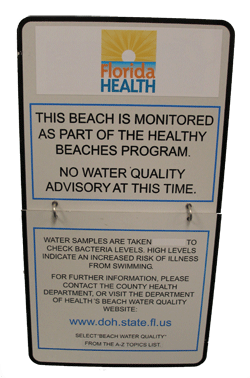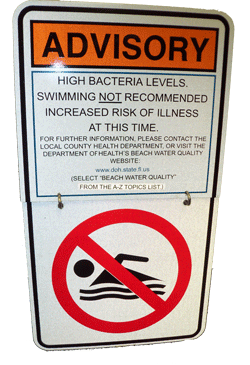It's a New Day in Public Health.
The Florida Department of Health works to protect, promote, and improve the health of all people in Florida through integrated state, county, and community efforts.
Healthy Beaches
Florida Department of Health in Pinellas County, Environmental Public Health
- 727-538-7277
- Pinellas_Environmental@FLhealth.gov
-
Fax
727-538-7293
Healthy Beaches Program

The Healthy Beaches Program monitors beaches by collecting bi-weekly water samples throughout the year and analyzes them for enterococci. These organisms are chosen since they inhabit the intestines of warm blooded animals and are excreted through the animal's waste. Enterococci do not necessarily cause illness but at high concentrations, it may indicate that there are other organisms present that could cause disease, infections, and rashes.
Based on EPA guidelines, when these organisms reach high levels, a health advisory is issued by the department. Public notifications include results entered on the Healthy Beaches Website, signs posted at the beach, notifying the media, and informing the local government officials. Health advisories are not lifted until samples collected show acceptable water quality. The health department also works closely with local governments and other agencies to investigate possible sources of the contaminant.
Beach Water Quality Results
Water Quality Results Reported Bi-Weekly
Program History

Beginning in 1998, Pinellas County was one of 5 counties in the State who were
selected to participate in the Florida Healthy Beaches Pilot Program. As a part of its
participation, the Florida Department of Health in Pinellas County conducted beach water sampling
and reporting of bacteria levels at eight area beaches every other week.
Because of the success of the program, starting August 1st, 2000, ALL coastal counties throughout the State of Florida monitored their beaches in this way and posted the results on the world wide web. The current Healthy Beaches sampling program collects and analyzes water samples at nine sites around Pinellas County every week to monitor the levels of indicator bacteria, specifically Enterococcus sp. The presence of this enteric bacteria is a possible indication of fecal pollution, which may come from any or all of the following: pets, wildlife (aquatic/terrestrial), human sewage, or stormwater runoff.
Both bacteria are microorganisms that are found in the intestines of humans and other animals, and are commonly used as indicators of fecal pollution in drinking water. Occurrence of these bacteria indicate the possibility of the existence of pathogens that can cause gastrointestinal illness. While fecal coliform is a common indicator of fresh water quality, the addition of enterococci bacteria, an indicator bacteria which has shown a strong correlation to pathogens in marine water, is a unique component of the Healthy Beaches Program.
What to Look for...
The Florida Department of Health in Pinellas County collects water samples at 10 sites along the Gulf Coast and Tampa Bay every other week. The samples are analyzed to monitor the levels of bacteria in the water at our public beaches. When the level of bacteria in a sample exceeds established guidelines, an advisory is issued to beachgoers stating that it may not be healthy for you to go into the water. This advisory is published in the local newspaper and these signs are posted at the beach site to warn beachgoers.

From This...

...To This



Connect with DOH